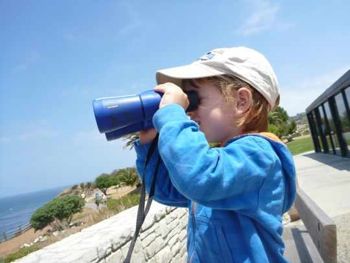I'm enjoying a seabirds' eye view of pure blue. Ocean and sky are in a gentle mood. The salty breeze whispers of wilder winds far off, as I gaze at a shimmering circle through the binoculars.
I'm scanning the world for whales.
These are the cliffs of Palos Verdes, nosing into the Pacific, south of Los Angeles, the next point of call on our journey following the grey whale migration, from Mexico to the Arctic. It's taken hours to piece the miles together by train, boat, bus, and by plane where absolutely necessary.
Northbound mothers and babies come by here in droves in late April and early May. They've been spotted this last week and my heart quickens at any movement.
But so far, no good, it's just rolling sea. No arching grey backs, no heart-shaped blow.
150 years ago shore-whalers also scanned these waters with hope. They gave chase using small boats powered by a single sail and oars. It was perilous. A harpooned whale could pull a boat for many miles. But the rewards for barrels of whale oil drove them on.
The breeding lagoons of Baja, Mexico, have a bloody history too, though you'd never guess it from the whales that let us touch them at the start of our journey. In the late 1800s, whaling captain Charles Scammon and his crew killed nearly all the visiting whales in two brutal seasons, targeting nursing or pregnant females. The grey was named devil-fish by the whalers because of the desperate ferocity the females demonstrated when separated from their calves, charging and overturning boats.
I wonder what Charles Scammon felt when, later in his life, he wrote about the greys, describing the affection between mother and calf and wondering if the species would survive.
It has recovered from near-extinction twice, the second time in the 1900s after decimation by factory ship whaling. There are now more than 20,000 roaming the seas but I can't spot a single one.
I call Alisa Schulman-Janiger for help. A marine biologist from the LA chapter of the American Cetacean Society, Alisa has coordinated the grey whale census at Palos Verdes for 30 years. A dedicated band of volunteer 'citizen scientists' work three to five hour shifts starting at 6 a.m, during a five-month whale counting marathon.
This year saw 1,152 northbound whales, with 138 cow/calf pairs, the seventh highest number of mother/baby pairs in the 30-year count. It's amazing to imagine the baby whales I kissed in Baja among that northbound wave.
The grey's lot isn't rosy everywhere though. The western population, based in Siberia, has been hunted almost to extinction, with somewhere around 100 remaining.
Genetic studies suggest the two populations don't interbreed but tagging has shown some western greys cross over to the lagoons in Baja. How do they recognize each other to avoid mixing? 'Do they have different accents?' Alisa half-jokes.

Laughter and chattering announces a school visit at the Point Vicente Interpretive Centre's whale exhibition, behind me. I'm examining a pile of kelp to make sure it's not a whale, I think I glimpse a couple of backs but can't be sure. The two-year-old tries it fleetingly, 'No whales. They've gone', he hands the binoculars back and returns to an animated conversation between his toy van and a cactus.
We check out the exhibition. There are huge models of the greys, which I grudgingly suppose might be better than none at all. One has hatches that open to display the brain, stomach, and developing foetus. The two-year-old is delighted. I love that he's learning about these natural wonders so early and so viscerally.
The oceans, and the life they hold, have always been a source of strength for me. My hope is that even if he forgets most of this, the whales will somehow remain with him, and help him too. While he scampers through a sea cave, with a lovely volunteer guide, I sneak another wistful look out to sea. Where are you my barnacled sea monsters?
I call Wayne Perryman, further north in Point Piedras Blancas, to ask if he's seeing greys. He's a marine biologist for NOAA's Southwest Fisheries Science Centre and yes, he spotted three cow/calf pairs the day before.
Wayne says the count is vital, 'We think the number of calves is linked to ice cover in the Arctic... An earlier ice melt allows easier access to feeding grounds but warmer water means fewer of the tiny creatures they eat.' Wayne says that if the females have not reached a critical weight by a certain stage, the pregnancy does not go to term, and it can take years for whales to recover and store up enough blubber to reproduce. 'There are several factors affecting how many calves are born each year', he explains.

Wayne's team takes to the skies to observe whales, examining shape and spotting pregnancies from above. The aerial pictures they've captured of cow/calf pairs are beautiful, the calves smaller copies of their mothers. They look so vulnerable, travelling through the vast ocean.
The guide from the exhibition offers us a lift to our hotel, to save us waiting for buses in the heat. It's so kind of her, as though she wanted to make up for our disappointment today. As we drive through coastal sage scrub, she confides that she can't spot the whales, unless a blue comes past with its giant spout.
I spend the afternoon being directed in sandcastle construction. The power of the surf on the beach is breathtaking. I like swimming in rough water: we come from a small island with savage tides and currents. But this looks mightier, and dangerous. Suitable for whales, not me.
Tomorrow we'll catch the train north to Monterey and see if we can spot them there.
Patting a sand turret into place, the two-year-old makes a more adventurous suggestion, 'We need to catch up with the whales mummy, I will build you a boat, okay?'